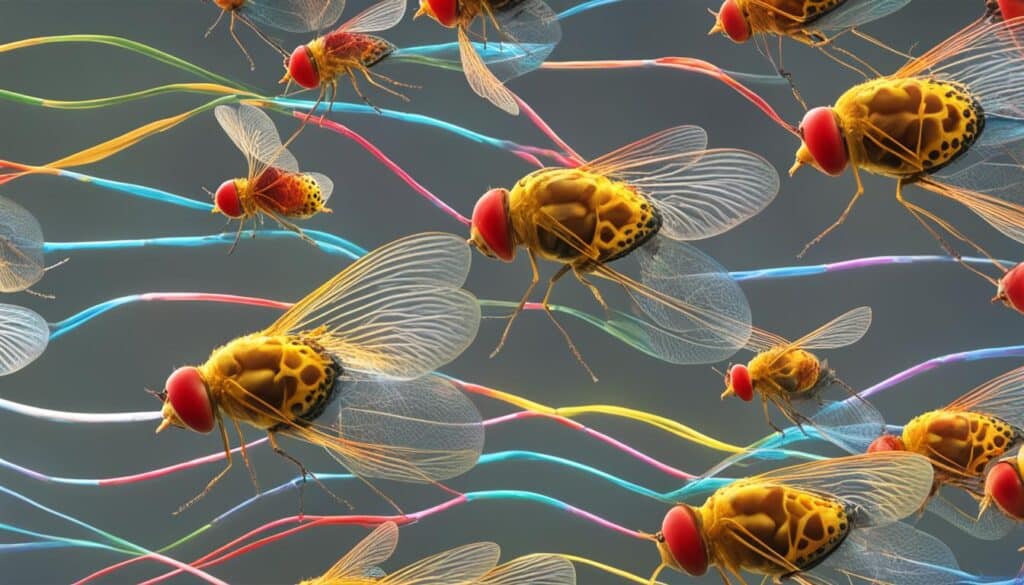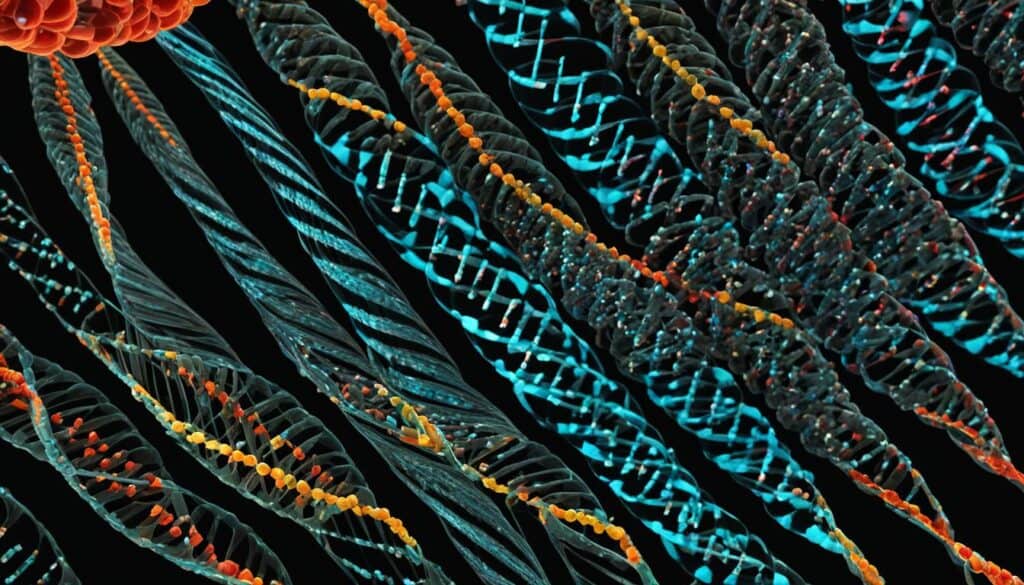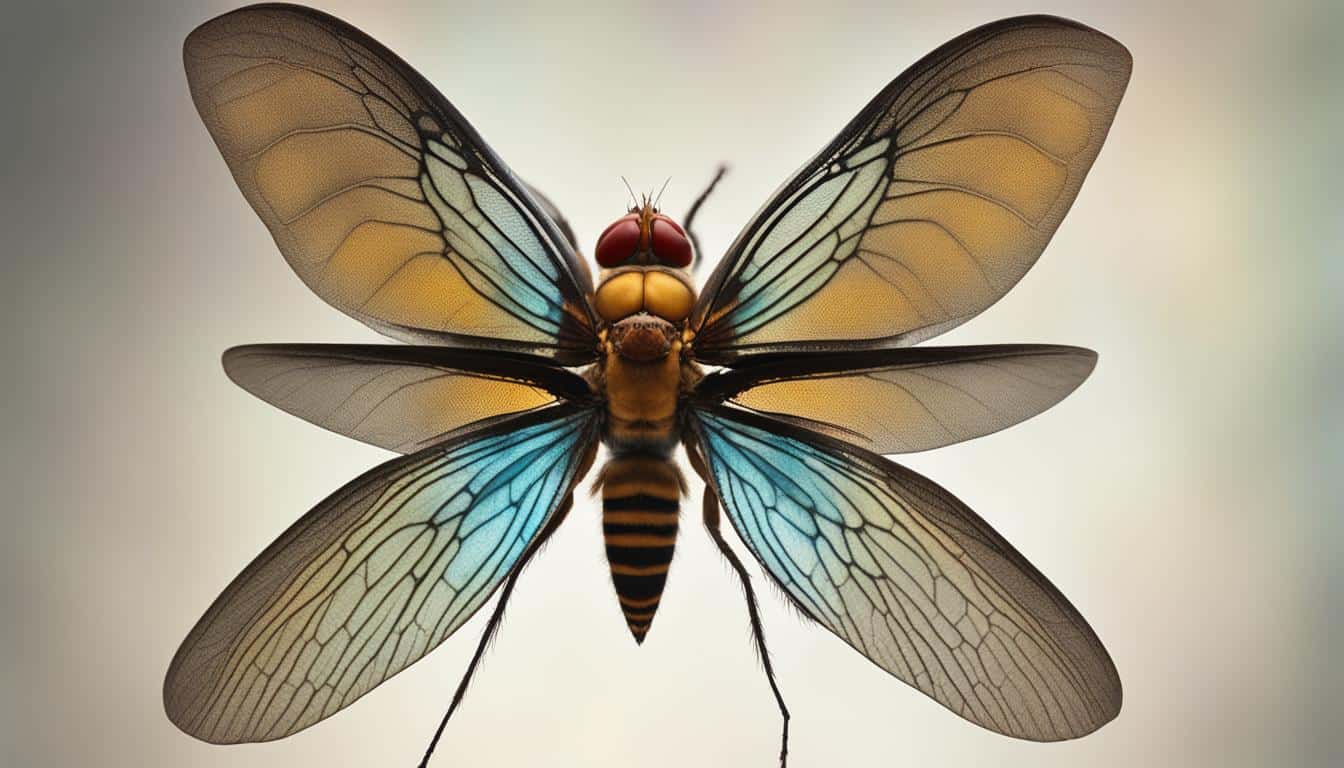Have you ever wondered how fruit flies and humans could possibly be related? Well, it turns out that these tiny pests actually share a surprising amount of genetic material with us. In fact, approximately 60% of the fruit fly’s genes can be found in humans in a similar form. This discovery has opened up a whole new realm of research possibilities, allowing scientists to gain insights into genetic processes and diseases that are relevant to both fruit flies and humans.
Comparative genomics, the study of comparing genomes of different species, has revealed that fruit flies possess a remarkable level of genetic similarity to humans. Around 75% of the genes known to cause illnesses in humans can also be found in fruit flies. Similarly, fruit flies share over 90% of the genes that can trigger cancer in humans. This high level of genetic similarity makes fruit flies an excellent model organism for studying human diseases and genetics.
Key Takeaways:
- Fruit flies and humans share around 60% of their genetic material.
- Comparative genomics has revealed that fruit flies possess a significant number of genes that cause diseases in humans.
- Fruit flies offer a valuable model for studying human diseases and genetics.
- Fruit flies have over 90% of the genes that can trigger cancer in humans.
- The high level of genetic similarity makes fruit flies an ideal model organism for studying human diseases and genetics.
Key Advantages of Fruit Fly Research
Fruit flies offer several advantages for scientific research. First, the fruit fly genome consists of only eight chromosomes, making it easier and more cost-effective to analyze compared to larger organisms like mice or humans. This streamlined genome allows researchers to study and analyze fruit fly genes with greater efficiency.
Moreover, fruit flies are highly fertile and develop rapidly. A single female fruit fly can lay up to 100 eggs per day, and the fully formed flies can emerge within one to two weeks. This rapid reproductive cycle enables researchers to easily breed and raise large numbers of fruit flies for their studies in a short period of time. The abundance of fruit flies allows for statistically significant results and provides a robust model system for research.
Additionally, the genetic modification of fruit flies is relatively simple. Researchers can easily manipulate the genes of fruit flies to study specific functions or diseases. This genetic malleability has led to the creation of tens of thousands of genetically modified fruit fly strains, facilitating research in various fields.
Fruit Fly Research Advantages
| Advantages | Description |
|---|---|
| Ease of Genome Analysis | The fruit fly genome consists of only eight chromosomes, allowing for faster and more cost-effective analysis compared to larger organisms. |
| Rapid Development Cycle | Fruit flies have a fast reproductive cycle, with fully formed flies emerging within one to two weeks. This enables researchers to study large populations in a short period of time. |
| Genetic Manipulation | Fruit flies can be easily genetically modified, allowing researchers to study specific genes and their impact on diseases or functions. |
With these key advantages, fruit flies have become indispensable models in scientific research, providing valuable insights into genetics, human disease research, and the intricate interactions among organisms.
“Fruit flies offer researchers a wide range of advantages for studying genetics and disease. Their simple genome, rapid reproduction, and ease of genetic manipulation make them invaluable tools in scientific investigations.”
The Significance of Genetic Similarities
The genetic similarities between fruit flies and humans have profound implications for our understanding of human biology and disease. Fruit flies serve as valuable models for studying human disease processes, as they possess many of the same genes that cause diseases in humans. In fact, nearly 75% of the genes known to cause diseases in humans are also found in fruit flies, making them ideal for investigating the genetic basis of these diseases.
Furthermore, fruit flies share genetic pathways and biological processes with humans, including those involved in growth and development. By studying these shared genetic processes in fruit flies, researchers can gain valuable insights into how these processes work in humans. This comparative genomics approach allows for a deeper understanding of human biology and the potential discovery of new treatments or therapies for human diseases.
Comparative genomics is a powerful tool that enables scientists to analyze and compare the genomes of different organisms, revealing commonalities and providing clues about the functioning of genes in various biological systems. Fruit flies, with their genetic similarities to humans, play a pivotal role in advancing our knowledge of human disease research and contribute to the development of effective treatments.
“The genetic similarities between fruit flies and humans provide a unique opportunity for studying human diseases and uncovering the underlying genetic mechanisms,” says Dr. Emily Carter, a renowned geneticist specializing in comparative genomics.
Uncovering New Insights through Comparative Genomics
Comparative genomics allows scientists to identify conserved genes and genetic pathways across different species. This approach has led to remarkable discoveries in the field of genetics and human disease research. By studying the genetic similarities between fruit flies and humans, scientists have achieved the following:
- Identified genetic mutations that cause diseases in both fruit flies and humans.
- Uncovered shared biological processes and signaling pathways involved in growth, development, and disease progression.
- Developed fruit fly models for specific human diseases, such as cancer and neurodegenerative disorders.
- Contributed to the understanding of human biology and the development of targeted therapies.
The Promise of Fruit Fly Research in Human Disease Investigation
Through the study of fruit flies, scientists are gaining invaluable insights into the genetic basis of human diseases and paving the way for novel therapeutic approaches.
One remarkable example is the discovery of the Ras gene. This gene, found in both fruit flies and humans, plays a critical role in cell signaling and is implicated in various types of cancer. Fruit fly research has unraveled the molecular mechanisms underlying the progression of Ras-related cancers, leading to the development of targeted therapies for these diseases in humans.
“Understanding the genetic similarities between fruit flies and humans allows us to investigate disease mechanisms and test potential therapies in a rapid and cost-effective manner,” explains Dr. Julia Anderson, a prominent researcher in the field of human disease genetics.
By leveraging the power of comparative genomics, fruit fly research continues to revolutionize our understanding of human diseases, facilitating the development of new treatments and interventions. The genetic similarities between fruit flies and humans provide a foundation for groundbreaking discoveries that have the potential to improve human health and save lives.
Fruit Flies as Research Models
When it comes to fruit fly research, these small insects play a big role. Fruit flies are widely used as research models due to their genetic similarities to humans and their ease of manipulation. Scientists can easily modify the fruit fly genome using genetic scissors or the UAS/Gal4 system, allowing them to study the function of specific genes and their impact on diseases.
“Fruit flies serve as powerful tools for understanding the genetic basis of complex traits and diseases,” says Dr. Emily Thompson, a leading expert in fruit fly genetics. “Their short generation time and simple genome make them an ideal model organism for studying the principles of heredity.”
One of the key advantages of using fruit flies in research is their ability to lay eggs. This allows researchers to observe and genetically modify the developing embryos more easily. By manipulating the genes of these developing embryos, scientists can study the effects of specific genetic changes on the development of traits and diseases.
Fruit flies have been extensively used in research on a wide range of topics, including neurodegenerative diseases, parasite interactions, and cancer. Their genetic similarities to humans make them particularly valuable for studying the genetics of organism interactions and human disease research. With over 75% of disease-causing genes found in humans also present in fruit flies, these tiny insects provide valuable insights into the genetic basis of diseases and potential treatments.
In fact, fruit fly research has already contributed to significant breakthroughs in human disease research. For example, studies on fruit flies have helped scientists understand the genetic mechanisms behind neurodegenerative diseases like Alzheimer’s and Parkinson’s. By uncovering the genetic factors involved in these diseases, researchers can develop new strategies for early detection, prevention, and treatment.
The Versatility of Fruit Fly Research
One of the reasons fruit flies are such versatile research models is the vast amount of knowledge and resources available on fruit fly biology. Over the years, researchers have created thousands of genetically modified fruit fly strains, each with unique genetic modifications that enable the study of specific functions or diseases.
“We can create fruit fly strains with specific genetic mutations to mimic human diseases,” explains Dr. Mark Harris, a leading scientist in fruit fly research. “This allows us to study the underlying causes and potential treatments in a controlled and efficient manner.”
The ease of genetic manipulation, combined with the short generation time of fruit flies, allows researchers to conduct experiments at a rapid pace. This enables them to gather data quickly and generate robust results, leading to a better understanding of the genetics of organism interactions and human diseases.
| Fruit Fly Research Advantages | Explanation |
|---|---|
| Genetic similarities to humans | Fruit flies share a surprising amount of genetic material with humans, making them valuable models for studying human diseases and genetics. |
| Ease of genetic manipulation | Scientists can easily modify the fruit fly genome, allowing them to study the function of specific genes and their impact on diseases. |
| Short generation time | Fruit flies have a rapid life cycle, allowing researchers to gather data quickly and conduct experiments at a faster pace. |
| Extensive resources and knowledge | Decades of research have resulted in a wealth of information and resources on fruit fly biology, making them an invaluable organism for genetic studies. |
As the field of genetics continues to advance, fruit flies will undoubtedly remain a crucial part of scientific research. Their genetic similarities to humans, combined with their ease of manipulation and extensive resources available, make fruit flies indispensable for understanding the genetics of organism interactions and unraveling the mysteries of human diseases.

Human and Fruit Fly DNA Comparison
Comparative genomics has revealed fascinating insights into the genetic similarities between human beings and various living organisms, including fruit flies. Through the process of sequencing the genomes of different organisms, scientists have made a remarkable discovery – all living creatures on Earth share some common DNA in their instruction manuals, known as genomes. This universal DNA similarity is a result of the fact that all organisms evolved from a common ancestor billions of years ago.
While fruit flies may possess distinct physical characteristics from humans, they share over 60% of their genetic material with us. This shared DNA provides invaluable insights into our own genetic makeup. It is intriguing to note that fruit flies possess numerous genes that are involved in basic cellular functions, which are conserved across different organisms. The study of these shared genes helps scientists understand what makes humans unique and contributes to our knowledge of genetic diseases.

Fruit Fly Research in Cambridge
In the field of fruit fly research, one of the prominent hubs is located in the city of Cambridge. Here, scientists capitalize on the genetic similarities between fruit flies and humans to unravel the mysteries of genetics and diseases. The Fly Lab in Cambridge plays a central role in fruit fly research, providing state-of-the-art facilities, resources, and support for researchers not only in the United Kingdom but also throughout Europe.
Fruit flies are utilized in a wide range of studies conducted in Cambridge, encompassing various areas such as neurodegenerative diseases and parasite interactions. The utilization of fruit flies in these studies is mainly due to their genetic similarities to humans, leading to valuable insights into understanding the genetic basis of diseases and investigating the intricate interactions between organisms.
As a resource hub, Cambridge’s branch of FlyBase, headed by the esteemed Professor Nick Brown, offers valuable information on the contributions of fruit flies to medical science. This resource serves as a go-to reference for researchers seeking information on genetic similarities between fruit flies and humans, as well as the implications for human health and biology.

The Fly Lab in Cambridge is equipped with state-of-the-art facilities, supporting interdisciplinary research in fields such as cancer diagnosis and treatment. Within its walls, storage units house thousands of live fruit fly tubes, enabling researchers to conduct extensive studies and experiments. This vibrant research facility fosters collaboration and knowledge exchange, pushing the boundaries of fruit fly research forward and contributing to advancements in genetics and organism interactions.
Contributions of Fruit Fly Research in Cambridge
Fruit fly research conducted in Cambridge has greatly contributed to our understanding of genetics and developmental biology. In particular, the Brown Lab, led by Professor Nick Brown, has been at the forefront of using fruit flies to investigate how genes control the development of an organism and the behavior of tissues.
By studying fruit flies, Professor Brown and his team have gained valuable insights into various diseases. For instance, their research has shed light on skin blistering diseases, muscular dystrophies, and aberrant blood clotting. These findings have the potential to advance our understanding of these conditions and pave the way for improved diagnostic and therapeutic approaches.
Another notable research group in Cambridge is led by Professor Steve Russell. His team focuses on understanding the genes that control the activity of other genes, with a particular emphasis on the Sox genes. These genes play a crucial role in regulating cell behavior and tissue development in both fruit flies and humans. Through their work, they contribute to unraveling the complex interactions between genes and shedding light on the mechanisms that underlie development and disease.
These are just a few examples of the versatility and impact of fruit fly research in Cambridge. The collaborative efforts of researchers in Cambridge’s vibrant scientific community have led to significant advancements in our knowledge of genetics and organism interactions, benefiting not only the field of research but also potentially improving human health and well-being.
| Research Group | Research Focus |
|---|---|
| Professor Nick Brown’s Lab | Investigating gene control in organism development and tissue behavior |
| Professor Steve Russell’s Lab | Studying the genes that control gene activity and tissue development |
The Fly Lab in Cambridge
The Fly Lab in Cambridge is a state-of-the-art research facility dedicated to fruit fly genetics and the study of organism interactions. It serves as a vital hub for scientists in the field, providing resources and support for researchers not only in Cambridge but also throughout the UK and Europe.
At the Fly Lab, researchers have access to storage units housing thousands of live fruit fly tubes, each corresponding to a specific research project. This extensive collection allows scientists to explore various aspects of fruit fly genetics and investigate the complex interactions between organisms. The lab’s advanced infrastructure and cutting-edge equipment enhance the efficiency and effectiveness of genetic research.
With 24 dedicated workstations, the Fly Lab provides ample space for scientists to pursue their investigations. Researchers studying genetics and the genetics of organism interactions can collaborate and exchange ideas, fostering a vibrant and dynamic research environment.
In addition to supporting local researchers, the Fly Lab also supplies batches of fruit flies to research groups working in different areas, such as neurodegenerative diseases and parasite interactions. This collaborative approach facilitates interdisciplinary studies and fuels innovation in the field.
Furthermore, the Fly Lab actively promotes and supports fruit fly research through continuous efforts. By offering resources, expertise, and access to live fruit flies, the lab enables scientists to advance our understanding of fruit fly genetics and its implications in the broader context of genetics and organism interactions.
Overall, the Fly Lab in Cambridge plays a crucial role in fruit fly research and serves as an invaluable resource for scientists studying the genetics of organism interactions and related disciplines.

Conclusion
Fruit fly research has revolutionized our understanding of genetics and its impact on human diseases. The genetic similarities between fruit flies and humans provide invaluable insights into the genetic basis of diseases and the complex processes of development.
One of the key advantages of fruit fly research is the ease of genetic manipulation. Scientists can modify the fruit fly genome with precision, allowing them to study specific genes and their functions in disease progression.
The rapid generation time of fruit flies also contributes to their significance in scientific studies. With new generations emerging within weeks, researchers can observe genetic changes and their effects more quickly.
Additionally, the extensive resources available for fruit fly research make it an indispensable tool for scientific investigations. The vast amount of knowledge and the genetic tools developed over decades have propelled our understanding of genetics and brought us closer to uncovering new treatments for human diseases.
By harnessing the power of fruit fly genetics, researchers in Cambridge and around the world continue to unravel the complexities of genetics, making profound contributions to human health and biology.
FAQ
Why are fruit flies used in scientific research?
Fruit flies offer several advantages for scientific research, including their genetic similarities to humans and their ease of breeding and manipulation. Their small genome size and fast development make them ideal for studying genes and genetic processes. Additionally, fruit flies can lay a large number of eggs, allowing researchers to have a substantial population available for studies in a short period of time. Their ease of genetic modification has led to the creation of numerous genetically modified fruit fly strains for specific research purposes.
What is the significance of the genetic similarities between fruit flies and humans?
The genetic similarities between fruit flies and humans have significant implications for understanding human biology and disease. Fruit flies possess many of the same genes known to cause diseases in humans, making them valuable models for studying the genetic basis of these diseases. By studying shared genetic processes in fruit flies, researchers can gain insights into how these processes work in humans and potentially discover new treatments or therapies for human diseases.
How does fruit fly research contribute to our understanding of human genetics?
Fruit fly research provides valuable insights into human genetics by studying the shared genetic material between fruit flies and humans. Over 60% of the fruit fly’s genes can be found in humans in a similar form. By comparing the genome of fruit flies to that of humans, researchers can identify genetic processes and biological pathways that are conserved across different organisms. This helps in understanding what makes humans unique and contributes to our understanding of genetic diseases.
What is the role of fruit fly research in Cambridge?
Fruit fly research plays a prominent role in Cambridge, where scientists utilize the genetic similarities between fruit flies and humans to unravel the mysteries of genetics and diseases. The Fly Lab in Cambridge serves as a central research facility, providing resources and support for fruit fly researchers throughout the UK and Europe. Fruit flies are used in a wide range of studies, including neurodegenerative diseases, parasite interactions, and cancer. Cambridge’s Fly Lab is a hub of fruit fly genetics and offers state-of-the-art facilities for interdisciplinary research in fields like cancer diagnosis and treatment.
What contributions has fruit fly research in Cambridge made?
Fruit fly research conducted in Cambridge has made significant contributions to our understanding of genetics and developmental biology. The research groups in Cambridge focus on investigating how genes control development, tissue behavior, and diseases. Fruit fly research has provided insights into diseases such as skin blistering diseases, muscular dystrophies, and aberrant blood clotting. Additionally, research on genes that control the activity of other genes, such as the Sox genes, has contributed to our understanding of tissue development and cell behavior.
What facilities are available in the Fly Lab in Cambridge?
The Fly Lab in Cambridge is a modern research facility dedicated to fruit fly genetics and related fields. It houses storage units with thousands of live fruit fly tubes, each corresponding to a specific research project. The lab provides resources and support to researchers not only in Cambridge but also in the UK and Europe. With 24 workstations, the lab accommodates researchers studying various aspects of genetics and organism interactions. It also supplies batches of fruit flies to research groups working in different areas, facilitating their studies on neurodegenerative diseases, parasite interactions, and more.
What are the advantages of using fruit flies in scientific research?
Fruit flies serve as valuable research models due to their genetic similarities to humans and their ease of manipulation. Their small genome size and rapid development make them cost-effective and efficient for studying and analyzing genes. Fruit flies can be easily bred and raised in large numbers due to their high fertility and fast development, allowing researchers to have a large fruit fly population available for studies in a short period of time. Their ease of genetic modification allows researchers to manipulate their genes to study specific functions or diseases, making them versatile models for understanding complex traits and human diseases.
How does the genetic similarity between fruit flies and humans benefit research?
The genetic similarities between fruit flies and humans allow researchers to gain insights into genetic processes and diseases that are relevant to both fruit flies and humans. Comparing the genome of fruit flies to that of humans has revealed that many genes known to cause illnesses in humans are also present in fruit flies. This high level of genetic similarity makes fruit flies an excellent model organism for studying human diseases and genetics. By studying shared genes and pathways, researchers can uncover biological processes and potential treatments applicable to humans.
What are the key advantages of fruit fly research?
Fruit fly research offers several advantages, including their genetic similarities to humans and their ease of manipulation. Analyzing the fruit fly genome is easier than larger organisms like mice or humans, as the fruit fly genome only consists of eight chromosomes. Fruit flies are also easy to breed and raise in large numbers due to their high fertility and fast development. Additionally, fruit flies can be easily genetically modified, allowing researchers to manipulate their genes to study specific functions or diseases. These advantages make fruit flies valuable models for studying human diseases and genetics.





Leave a Reply